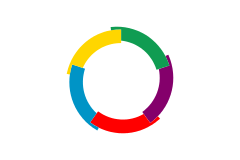French-based creole languages
A French creole, or French-based creole language, is a creole language (contact language with native speakers) for which French is the lexifier. Most often this lexifier is not modern French but rather a 17th-century koiné of French from Paris, the French Atlantic harbors, and the nascent French colonies. French-based creole languages are spoken natively by millions of people worldwide, primarily in the Americas and on archipelagos throughout the Indian Ocean. This article also contains information on French pidgin languages, contact languages that lack native speakers.
 |
| Part of a series on the |
| French language |
|---|
|
| History |
| Grammar |
| Orthography |
|
| Phonology |
|
These contact languages are not to be confused with contemporary (non-creole) French-language varieties spoken overseas in, for example, Canada (mostly in Quebec and the Maritime Provinces), the Canadian Prairie provinces, Louisiana, northern New England (Maine, New Hampshire, and Vermont). Haitian Creole is the most widely spoken creole influenced by French.
Classification
Americas
- Varieties with progressive aspect marker ape[1]
- Haitian Creole (Kreyòl ayisyen, locally called Creole) is a language spoken primarily in Haiti: the largest French-derived language in the world, with an estimated total of 12 million fluent speakers. It is also the most-spoken creole language in the world and is based largely on 17th-century French with influences from Portuguese, Spanish, English, Taíno, and West African languages.[2] It is an official language in Haiti.
- Louisiana Creole (Kréyol la Lwizyàn, locally called Kourí-Viní and Creole), the Louisiana creole language.
- Varieties with progressive aspect marker ka[3]
- Antillean Creole, spoken primarily in the francophone countries in the Lesser Antilles, such as Martinique, Guadeloupe, Îles des Saintes Although all of the creoles spoken on these islands are considered to be the same language, there are noticeable differences between the dialects of each island. Notably, the Creole spoken in the Eastern (windward) part of the island Saint-Barthélemy is spoken exclusively by a white population of European descent, imported into the island from Saint Kitts in 1648.
- Guianese Creole is a language spoken in French Guiana, and to a lesser degree in Suriname and Guyana. It is closely related to Antillean Creole, but there are some noteworthy differences between the two.
- Karipúna, spoken in Brazil, mostly in the state of Amapá. It was developed by Amerindians, with possible influences from immigrants from neighboring French Guiana and French territories of the Caribbean and with a recent lexical adstratum from Portuguese.
- Lanc-Patuá, spoken more widely in the state of Amapá, is a variety of the former, possibly the same language.
- Karipúna, spoken in Brazil, mostly in the state of Amapá. It was developed by Amerindians, with possible influences from immigrants from neighboring French Guiana and French territories of the Caribbean and with a recent lexical adstratum from Portuguese.
Indian Ocean
- Varieties with progressive aspect marker ape[1] – subsumed under a common classification as Bourbonnais Creoles
- Mauritian Creole, spoken in Mauritius (locally Kreol)
- Agalega Creole, spoken in Agaléga Islands
- Chagossian Creole, spoken by the former population of the Chagos archipelago
- Réunion Creole, spoken in Réunion
- Rodriguan Creole, spoken on the island of Rodrigues
- Seychellois Creole, spoken everywhere in the Seychelles and locally known as Kreol seselwa. It is the national language and shares official status with English and French.
Pacific
- Tayo, spoken in New Caledonia
Africa
- Petit Mauresque or Little Moorish was spoken in North Africa
- Français Tirailleur, a pidgin language[4] spoken in West Africa by soldiers in the French Colonial Army, approximately 1850–1960.
- Burundi Pidgin French (and similar pidgins in other francophone countries)
Asia
- Tây Bồi, a pidgin language spoken in former French colonies in Indochina, primarily Vietnam
See also
- Chiac
- Michif
- Joual
- Camfranglais, a macaronic language of Cameroon
Notes
- with variants ap and pe, from the koiné French progressive aspect marker àprè <après> Henri Wittmann. 1995, "Grammaire comparée des variétés coloniales du français populaire de Paris du 17e siècle et origines du français québécois", in Fournier, Robert, & Wittmann, Henri, Le français des Amériques, Trois-Rivières: Presses universitaires de Trois-Rivières, pp. 281–334.
- Bonenfant, Jacques L. (2011). "History of Haitian-Creole: From Pidgin to Lingua Franca and English Influence on the Language" (PDF). Review of Higher Education and Self-Learning. 3 (11). Archived (PDF) from the original on 23 March 2015.
- from the Karipúna substratum (Henri Wittmann. 1995, "Grammaire comparée des variétés coloniales du français populaire de Paris du 17e siècle et origines du français québécois", in Fournier, Robert & Wittmann, Henri, Le français des Amériques, Trois-Rivières: Presses universitaires de Trois-Rivières, pp. 281–334.
- Holm, J. A. (1989). Pidgins and Creoles: Volume 2, Reference Survey. Cambridge University Press. p. 357. ISBN 9780521359405. Retrieved 2 March 2015.